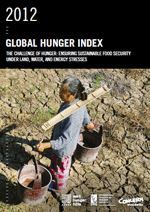Poverty causes hunger, even when food is enough for all
Published on Thu, 2012-11-01 11:26
“Decades of effort and rhetoric have failed to eradicate hunger in the world.” This is the emphatic and harsh conclusion of the Global Hunger Index. In 2000, more than a hundred presidents, kings, prime ministers and ministers from all over the world signed the Millennium Declaration in which they promised to spare no effort to, among other things, “cut by half (by 2015) the proportion of people suffering from hunger.” This goal will not be reached. More than a billion people will go to bed hungry tonight. There are more hungry people today than there were at the start of the century. The proportion has fallen because total world population has increased, but it has not fallen enough. The hunger index is the average of three indicators in each country: malnutrition (measured by the consumption of fewer calories than are needed), children under 5 being underweight, and infant mortality (which in turn stems from a combination of bad food and inadequate sanitary conditions). In 2000, more than a hundred presidents, kings, prime ministers and ministers from all over the world signed the Millennium Declaration in which they promised to spare no effort to, among other things, “cut by half (by 2015) the proportion of people suffering from hunger.” This goal will not be reached. More than a thousand million people will go to bed hungry tonight. There are more hungry people today than there were at the start of the century. The proportion has fallen because total world population has increased, but it has not fallen enough. At the global level, the Hunger Index has been decreasing slowly since the last decade of the 20th century: it declined from 19.8 in 1990 to 16.3 in 2001, an improvement of three and a half points. But in the first decade of the 21st century, in spite of solemn declarations, progress has slowed even more, and the world index improved by barely one and a half points in 11 years to reach 14.7 in 2012. This frustrating performance stands in contrast to good economic progress. From 1990 to 2011 world trade increased fourfold and average per capita income in the world doubled to its present level of around 10,000 dollars per year. This prosperity is very badly distributed. One dramatic example is India. Its economy is flourishing and average annual per capita income increased from 1,460 dollars in the mid 1990s to 2,850 in 2010, but hunger has barely decreased at all. Its index rating today is 23, which is among the worst in the world. South Asia (Bangladesh, India, Nepal and Pakistan) has become the worst region in terms of the Hunger Index with 22.5, while Sub-Saharan Africa improved over the last ten years and now stands at 20.7. However, some African countries are still in the most serious situation, particularly those affected by armed conflicts: Ethiopia, Eritrea, Burundi and the Democratic Republic of the Congo, where the index cannot even be calculated for lack of reliable data. Haiti is the only Latin American country among the worst ten in the world with a rating of 30 points. Next comes Guatemala (12.7), and then Bolivia (12.3), Nicaragua (9.1), Honduras (7.7), Ecuador (7.5) and Peru (7.4). At the other end of the scale we find Argentina, Chile, Costa Rica, Cuba and Uruguay, which in 1990 were already in the “low hunger” category with less than 5 points on the index. In 1990, Brazil, Mexico, Jamaica and Nicaragua had ratings of over 20 points but now they are among the countries that have made most progress in the fight against hunger in the world. On the other hand, the situation has worsened in Ivory Coast, North Korea, Burundi and Haiti. According to the report that accompanies these figures, hunger is not connected to the availability of food but to poor people’s possibilities of accessing food. The countries of the Sahel that have the worst hunger ratings have more food than they need when we add what they produce to what they import, without counting food aid. The report concludes that “The problem is no longer epidemic famines but the chronic vulnerability of some sectors of the population.” More information Source |
SUSCRIBE TO OUR NEWSLETTER



